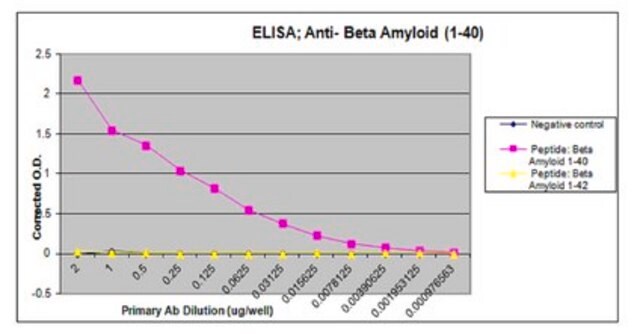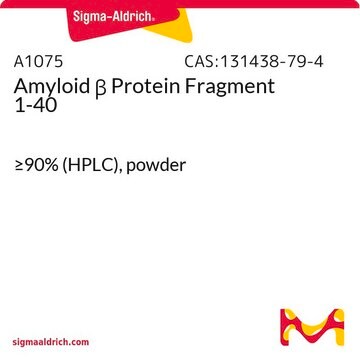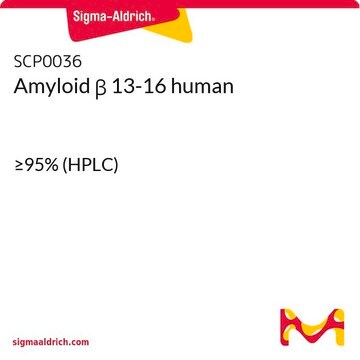SCP0033
Amyloid β 1-16 rat
Se connecterpour consulter vos tarifs contractuels et ceux de votre entreprise/organisme
About This Item
Formule empirique (notation de Hill):
C80H115N25O27
Poids moléculaire :
1858.92
Code UNSPSC :
12352200
Nomenclature NACRES :
NA.32
Produits recommandés
Pureté
≥95% (HPLC)
Forme
lyophilized
Composition
Peptide Content, ≥75%
Conditions de stockage
protect from light
Température de stockage
−20°C
Amino Acid Sequence
Asp-Ala-Glu-Phe-Gly-His-Asp-Ser-Gly-Phe-Glu-Val-Arg-His-Gln-Lys
Application
Amyloid β (Aβ) refers to peptides derived from Amyloid precursor protein that vary in length from 36-43 amino acids. Aβ(s) peptides, their peptide fragments and mutated fragments are used to study a wide range of metabolic and regulatory functions including activation of kinases, regulation of cholesterol transport, function as a transcription factor, and regulators of inflammation. Aβ(s) peptides and their peptide fragments are also used to study oxidative stress, metal binding and mechanisms of protein cross-linking in the context of diseases such as Alzheimer′s disease and neurodegeneration.
Code de la classe de stockage
11 - Combustible Solids
Classe de danger pour l'eau (WGK)
WGK 3
Point d'éclair (°F)
Not applicable
Point d'éclair (°C)
Not applicable
Certificats d'analyse (COA)
Recherchez un Certificats d'analyse (COA) en saisissant le numéro de lot du produit. Les numéros de lot figurent sur l'étiquette du produit après les mots "Lot" ou "Batch".
Déjà en possession de ce produit ?
Retrouvez la documentation relative aux produits que vous avez récemment achetés dans la Bibliothèque de documents.
Maryam Bagheri et al.
Neurobiology of learning and memory, 95(3), 270-276 (2010-12-15)
Alzheimer's disease (AD) is a debilitating neurodegenerative disorder characterized by increased β-amyloid (Aβ) deposition and neuronal dysfunction leading to impaired learning and recall. Ageing, heredity, and induced oxidative stress are among proposed risk factors. The increased frequency of the disease
Tania Araujo Viel et al.
Neurobiology of aging, 29(12), 1805-1814 (2007-06-16)
Although numerous inflammation pathways have been implicated in Alzheimer's disease, the involvement of the kallikrein-kinin system is still under investigation. We anatomically localized and quantified the density of kinin B(1) and B(2) receptors binding sites in the rat brain after
Lian Hong et al.
The journal of physical chemistry. B, 114(34), 11261-11271 (2010-08-10)
There is no consensus on the coordinating ligands for Cu(2+) by Abeta. However, the differences in peptide sequence between human and rat have been hypothesized to alter metal ion binding in a manner that alters Cu(2+)-induced aggregation of Abeta. Herein
Aynun N Begum et al.
Journal of Alzheimer's disease : JAD, 15(4), 625-640 (2008-12-20)
The rat amyloid-beta (Abeta) intracerebroventricular infusion can model aspects of Alzheimer's disease (AD) and has predicted efficacy of therapies such as ibuprofen and curcumin in transgenic mouse models. High density lipoprotein (HDL), a normal plasma carrier of Abeta, is used
Yan Wang et al.
Neuropharmacology, 62(2), 871-881 (2011-10-01)
Alzheimer's disease (AD) is a progressive neurodegenerative disease characterized by the accumulation of β-sheet-rich amyloid oligomers or fibrils which are associated with cellular toxicity in the brain. Inhibition of Aβ aggregation could be a viable therapeutic strategy for slowing and/or
Notre équipe de scientifiques dispose d'une expérience dans tous les secteurs de la recherche, notamment en sciences de la vie, science des matériaux, synthèse chimique, chromatographie, analyse et dans de nombreux autres domaines..
Contacter notre Service technique





